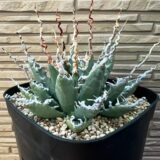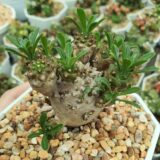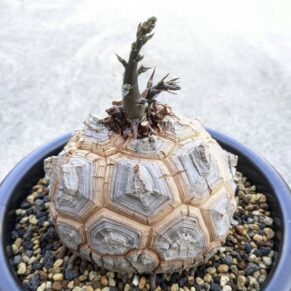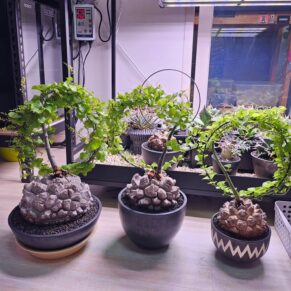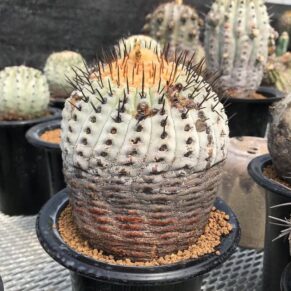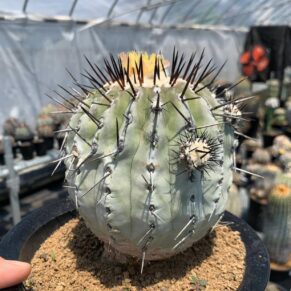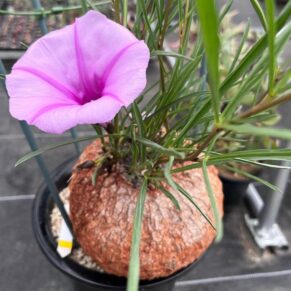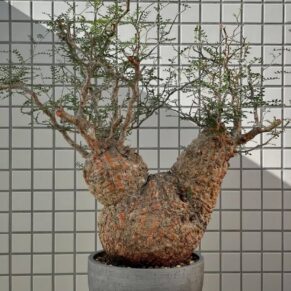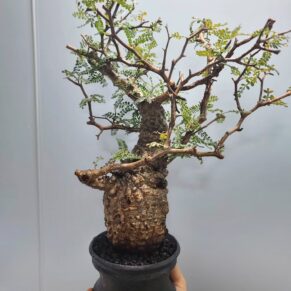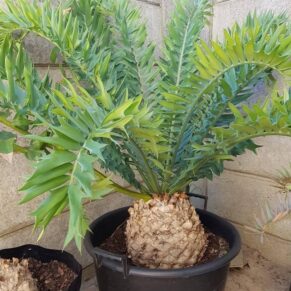- Your cart is empty
- Continue shopping
Shop
Euphorbia obesa
Introduction to Euphorbia obesa – The Baseball Plant
Euphorbia obesa, often called the baseball plant, is a remarkable, spherical succulent native to South Africa’s karoo region. Its nearly perfect ball shape—especially when young—makes it a striking ornamental specimen and a favorite among succulent collectors
E. obesa carries a unique charm: delicate stripes, evolving shape, and ease of care. On caudexplants.com, this species deserves center stage in your succulent collection offerings.shop here

Description & Morphology
Form & Size
Young Euphorbia obesa plants form a near-perfect globe, typically between 6–15 cm in diameter (smaller when young; up to ~20 cm tall as they mature) If you’re looking for where to buy plants visit caudexplants.com . The stem is unbranched, with eight shallow ribs adorned by evenly spaced gibbous tubercles
Color & Markings
The epidermis is grey‑green, often overlaid with horizontal bands that may be lighter or darker green. Under intense sunlight, Euphorbia obesa may show hues of red or purple, especially along the ribs Google.com.
Flowers & Reproduction
A dioecious species, E. obesa produces male or female flowers on separate plants. The inflorescences—which are minute, yellowish-green cyathia—emerge at the apex during summer . Female plants develop a three-angled fruit capsule that explosively ejects 2 mm seeds when ripe .If you’re looking for where to buy plants visit caudexplants.com
Latex & Toxicity
Like all euphorbias, Euphorbia obesa exudes a milky latex when damaged. This sap is toxic and can cause skin or eye irritation. Handling with gloves and eye protection is recommended facebook.com.
Native Habitat & Conservation Status
Natural Range
Endemic to the Great Karoo and areas south of Graaff-Reinet in Eastern Cape, South Africa, Euphorbia obesa thrives in stony shale terrain amid low shrubs at altitudes of ~300–900 m, experiencing summers of around 26 °C and frost on rare occasions .
Conservation
The species is endangered in the wild due to habitat loss and over-collection. Surveys estimate fewer than 500 mature individuals in a range under 1,000 km² . It is listed under CITES Appendix II and protected under South African legislation—commercial trade requires proper permits . Nonetheless, it is thriving in cultivation globally as an ex‑situ conservation success .

Cultivation & Care Guide
Light Requirements
True Euphorbia obesa Temperature & Humidity
Ideal temperature range falls between 18–28 °C (65–82 °F). It tolerates brief dips to approximately 6 °C (43 °F) if completely dry—prolonged frost or damp cold will cause damage . Humidity around 50–60 % is optimal; excessively moist air or soil invites fungal issues like mildew .
Soil & Drainage
A light, gritty succulent mix—such as a blend of coarse sand, perlite, decomposed granite, or palm/citrus potting soil—ensures excellent drainage, replicating its native karoo shale soil .
Watering
Water sparingly. During the growing season (spring to early autumn), allow the substrate to fully dry between thorough soakings. In winter, remain completely dry to prevent root rot . Avoid watering foliage or crown areas.
Feeding & Fertilization
Use a balanced, low-nitrogen succulent fertilizer—approx. monthly during active growth. Overfertilization can promote soft tissue rather than compact form .

Potting & Repotting
Repot only when root-bound or every 3–5 years. Choose a container slightly larger than before, and refresh soil mix. Spring is the best season to repot .
Propagation Methods
By Seed
True Euphorbia obesa plants can be grown from seed. To produce seeds, a male and female plant must be grown within pollination reach. Hand-pollination using a brush can improve success . Collect seed pods carefully—capsules explode and scatter seeds; use a cap or mesh to prevent loss . Sow seeds in a sandy, well-drained mix, lightly covered, kept warm and moist—germination usually occurs within ~3 weeks; flowering takes 5–8 years .
By Grafting (Advanced)
Some growers graft Euphorbia obesa onto sturdier rootstocks like Cotyledon. This speeds early growth and may improve form. Scions must be aligned accurately, secured, and allowed ~20 days to heal before full growth continues .
Pups & Hybrids
True E. obesa rarely produces offsets or pups, though hybrids may. These can be separated once matured and callused, using sterile cuts and rooting powder if desired .
Pests, Diseases & Common Problems
Rot & Moisture Issues
Excess water is the chief concern. Root rot stems from poor drainage or overwatering. Cold, damp winters are particularly damaging.
Fungal Issues
Powdery mildew (sometimes called “Euphorbia mildew”) may appear in humid conditions. Keep soil dry, ventilation good, and humidity moderate to reduce risk .
Pests
Occasionally mealybugs or scale insects may affect the stem. Treat with insecticidal soap or alcohol swabs.
Etiolation & Light Stress
Under insufficient light, plants may stretch and lose their compact appearance. Once etiolated, lower portions won’t recover bulk—though new growth may firm up .
Aesthetic Appeal & Landscaping Use
Decorative Qualities
Its perfect spherical form, complemented by subtle striping and occasional stress coloration, makes Euphorbia obesa a striking visual anchor. It aligns well with minimalist and modern design themes.
Indoor & Outdoor Use
Ideal as a potted specimen on window sills or patios. In warm arid climates (USDA zones 10–11) it can be used in outdoor rock gardens. Indoors, a south- or east-facing bright window is excellent Collection & Pairing
Pair Euphorbia obesa with other slow-growing succulents or caudiciforms (e.g. certain caudex plants) for contrast in form and scale. On caudexplants.com, you can highlight its place among caudiciform collections, showcasing its caudex-like swollen stem and water storage capability.
Hybridization, Varieties & Similar Species
Subspecies
There are two recognized subspecies:
-
Euphorbia obesa subsp. obesa: becomes taller than broad.
-
subsp. symmetrica: remains globose, discovered later and slightly different morphology
Hybrids
E. obesa hybrids (e.g. with E. globosa) are sold, though true beoebsa typically lacks offsets. Hybrids often produce pups and may grow faster Reddit.
Despite superficial resemblance to the Mexican cactus Astrophytum asterias, E. obesa is unrelated. The resemblance is a case of convergent evolution in adaptive form .
Handling & Safety Information
-
Always wear gloves and eye protection when handling** Euphorbia obesa**, especially when cutting or repotting.
-
Wash exposed skin immediately with soap and water if latex contacts it.
-
Keep plant away from pets and children, as ingestion can cause irritation or worse .

Euphorbia obesa

